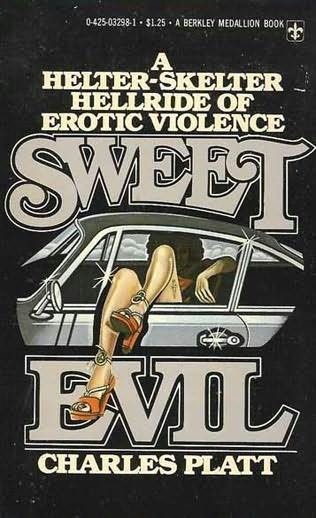 By CHARLES PLATT (Berkley; 1977)
By CHARLES PLATT (Berkley; 1977)
Charles Platt is best known for writing mainstream sci fi novels like TWILIGHT OF THE CITY and THE SILICON MAN, but I’ll always know him for 1970s-era sex and gore opuses like THE GAS and THE POWER AND THE PAIN, which remain among the most mind-scraping pornography you’ll ever read. SWEET EVIL follows suit, having been written for the notorious fuck book publisher Olympia Press, even though it wound up appearing as a mainstream paperback after Olympia went belly-up. At least the front cover blurb gives a fair warning of the content: “A Helter-Skelter Hellride of Erotic Violence.”
Platt described his conception of SWEET EVIL thusly: “Having exorcised most of my sexual inhibitions by writing erotica, I decided to plumb the depths of my ambivalence toward violence.” To this end he has Burt, a young hitchhiker looking for kicks, getting picked by Suzanne, a liberated woman on the run from the mob. The meeting, which takes place in the Arizona desert, proves deadly, seeing as how each inspires dark desires in the other. What transpires is a twisted odyssey of lust, rape and murder fleshed out in Platt’s unerringly concise and readable prose.
From the start Burt and Suzanne find themselves drifting into starkly amoral territory. Shortly after their first meeting—marked by a bout of compulsive sex—they pick up a young hitchhiker named Cheryl, who they quickly induct into their twisted dynamic. But Cheryl unexpectedly dies during one of their sadistic sex games. More killings ensue on a desperate road trip to Los Angeles, where B & S break into a rich man’s home and Burt rapes an aspiring porno actress. Following several more bouts of sex-fueled mayhem Burt and Suzanne wind up in a hippie commune, where a bizarre blood cult holds sway and the two engage in a final burst of cathartic sadomasochism.
The fact that this novel took several years to be published is evident in its theme of dropping out of society, along with the presence of a hippie cult and other elements inspired by the Manson family, all of which seem redolent of the early 1970s—and thus a tad outdated in a 1977 publication. In addition, many of the plot details are somewhat less than plausible (such as the fact that Burt and Suzanne always seem to be able to outrun the police far too easily).
What is quite plausible, and disturbingly so, is the twisted relationship between the protagonists. The manner in which this thrill-seeking duo graduate from illicit sex to rabid blood lust, and by extension from playful amorality to outright evil, is thoroughly convincing, and shot through with sexual encounters that define Burt and Suzanne’s relationship in the way they grow increasingly brutal and unhealthy. Obviously this isn’t a very nice book, but it does prove (and not for the first time) that Charles Platt was quite adroit at plumbing humanity’s darkest corners.
